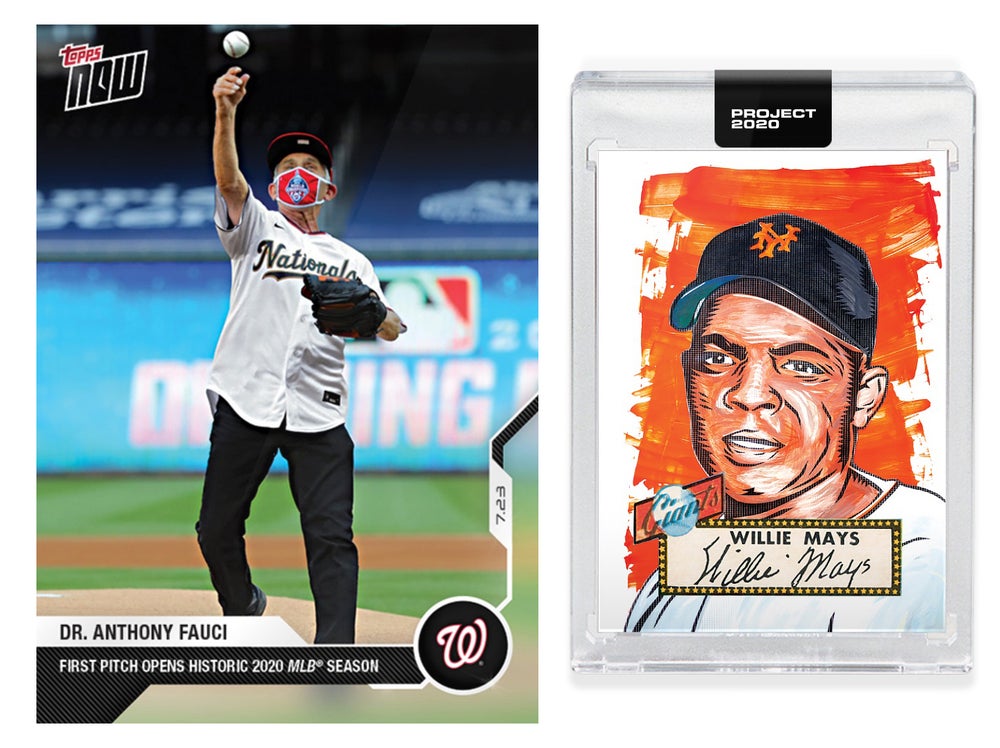Topps
September 14, 2020, 7 min read
When Dr. Anthony Fauci threw the first pitch at Nationals Park in Washington, D.C. on July 24, it was a headline-making moment — and not merely because his toss was wildly errant. The ceremonial heave also ushered in a baseball season that had been deferred for months due to concerns over Covid-19 (well-founded ones, given subsequent outbreaks in numerous clubhouses).
But what really got people talking was when trading-card company Topps announced that a limited-run, one-off card capturing Fauci’s moment on the mound sold out literally overnight, moving a record-breaking 51,512 units in a 24-hour window.
You’d be forgiven for thinking, “People still collect print trading cards?” But as Topps has figured out over the last several years, not only is there a market for the century-plus-old pastime, but it’s become more sophisticated and competitive among a select group of consumers who embody a Venn diagram where sports, nostalgia and street fashion intersect.

Dr. Fauci (l) and Willie Mays have made unlikely bedfellows in Topps’ limited-run series.
Image Credit: Topps
Fauci’s card was part of the lightning-in-a-bottle Topps Now series, which — as its name betrays — pounces on memorable heroics past and present with blink-and-you-missed-’em commemorative cards. (A snapshot of Dodgers second baseman Gavin Lux reaching a team milestone is still affordable, but save your pennies for those Derek Jeter throwbacks.) The brand has also maneuvered stealthily into the digital space, leveraging partnerships with not only sports leagues but entertainment powerhouses like Marvel and WWE to market numerous apps and virtual products.
Still, baseball is Topps’ bread and butter, and the company executed its most cutting-edge play to date with the Project 2020 line, which commissioned 20 street artists and designers to put a contemporary spin on 20 classic Topps baseball cards. The limited-edition set includes Tyson Beck’s emboldening of Roberto Clemente’s 1955 image, Ermsy’s fantastical animation of Dwight Gooden’s 1985 issue, and Blake Jamieson’s hyperreal redusting of Mike Trout’s rookie run.
“Project 2020 put baseball cards back on the map in a major way,” says Jamieson from his New York City studio. “In the ’80s and ’90s, which is really when I was collecting cards, all the companies were just over-printing hundreds and thousands of cards, and so nothing was really that rare. That turned a lot of people off because if everyone can just own every card, it’s not really as much fun as having a card that none of your friends can get.”
He describes the experience of participating in Project 2020 as something of a mutual-admiration immersion: “It’s really fun seeing all these different interpretations and how far each artist is pushing themselves and the boundaries of trading cards.”
Artist and designer Blake Jamieson at his NYC studio.
Image Credit: Bryan Cerda
Clay Luraschi, Topps’ vice president of product development, had a big hand in making Project 2020 — and the other, aforementioned campaigns — a reality. He recently caught up with us by phone from his home in New Jersey to break down how Topps has managed to preserve its legacy by remaining more relevant — and profitable — than ever.
Related: Strat-O-Matic’s Surge in Demand Is No Fantasy
Try, try and try again
“Having a massive presence online allows us to get our innovations out there to a lot of different collectors and fans, and innovations don’t always hit the first time,” Luraschi concedes. “You might have an idea, then you go back and tweak it. Sometimes it doesn’t even come to fruition for a couple of years. With Topps.com and our director-to-consumer business, we can print things on demand. We don’t have to necessarily take a position on a product, put it in a warehouse, and hope it sells out at some point. With a product like Project 2020 and other projects where you have an idea, but you’re not 100 percent sure how it’s going to perform, because it’s so different, [the site] allows you to put an idea out there and see how people respond.
Refine your core
“At the heart of it, we chronicle pop culture,” Luraschi offers. “Any property pretty much that’s ever been out there — whether it’s a film, a television show or anything — we’ve probably done a trading card of it, and that’s what we do. In this case, with Project 2020, we create a trading card of it, and then we put a twist on it. The team that put this together has always had a passion for arts, and I think the idea of arts, its meaning, and culture at this point in time has been made more available to everyone because of social media and the internet. There’s so much influence coming into our building from the outside, and instead of just saying, ‘We’re only going to do things a certain way,’ we’re inviting those influences and saying, ‘How can we look at this? How can we look at trading cards differently?'”
Maximize what you have that no one else has
“Whenever you can leverage your history, which a lot of companies can’t do, you should,” Luraschi recommends. “You should always be looking forward, but [Project 2020] is a way to kind of look back and forward at the same time. And to me, that’s the chemistry for success. If you can harness both those things at the same time, like if you can take an artist who’s completely cutting edge and does everything opposite of what you think a traditional artist does, and then takes this old trading card from the 1950s and reimagines that, that’s the perfect example of taking something old and new and having something great come out of it.”
Related: How The Country’s Goofiest Baseball Team Made Millions
Tap into your customer’s story
“I’m 46,” Luraschi begins. “I was a huge Giants fan growing up. You show me the 1986 Topps Traded Will Clark card, and I can talk about it for hours because just looking at that card leads to basically the story of my childhood. And that’s one thing we have that other companies don’t: I’m sure you can tell stories about a can of food, but it only goes so far. There’s such a deep connection people have with our cards. Ninety-nine percent of it is the connection your consumer has with the brand. How deep is that connection?”
Hire smart and stay fresh
“Whenever we hire someone, the wider their repertoire, and skillset, the better,” says Luraschi. “A lot of the people coming into the workforce now are thinking like that because of the mediums that they use and have grown up with. They’re constantly talking about social media platforms, about what’s hot, so they already come in with a natural lean toward those ideas. I’ve been at Topps 20 years, and I’m always pushing myself to think, ‘OK, what’s new?’ If you don’t, then what’s the point? My expectation is that whether you’ve been on the team for a month or 25 years, we stay on top of the trends that are not only that are going inside of our building, but outside of our building, too.”
This article is from Entrepreneur.com









